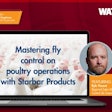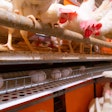
Higher feed costs are leading to lower turkey production and higher turkey prices.
In a WATT Poultry Chat interview, Dr. Thomas Elam, president of FarmEconLLC, reviewed crop condition in the U.S. and relevant market factors for the turkey industry.
Austin Alonzo: I know you want to talk about feed prices and how they're impacting turkey production in the United States.
Thomas Elam: Right, particularly corn and soybean meal prices. And it's pretty clear, at least in my mind, what's going on. We're going to talk about weather, we're going to talk about corn and soybean prices and then we're going to look at turkey production. They all tie together and make sense.
First of all, the Palmer drought severity index from last week. It shows a mild drought going on in Northern Iowa and Minnesota. And if you go back a couple of weeks, it was even much more severe than that. The second slide is something called the crop moisture index. The Palmer is a long-term moisture indicator, the crop moisture index indicates the soil condition in the top layers of the soil profile. We've had a lot of rain in the Midwest lately. And you can clearly see if you put those two side by side that both Iowa, which is cleared up entirely, and Minnesota is largely cleared up from severe drought. So the crop conditions have improved. However, we saw a big shift in the soybeans this year out of corn, and the combination of this dry weather in the northern Corn Belt and that acreage shift has led to some major changes in corn and soybean prices. In particular our soybean meal, which of course comes from soybeans.
I've put together three price indices where January 2020 equals 100. At one time, in the middle of last year, that index for corn was down to 80. And now it's up to 180. So that's more than doubled. Corn prices were running around $7 a bushel in a lot of Midwest locations. Whereas we were $3.50 or so last year. Of course, corn is by far the most prevalent source of carbohydrates in turkey diets and this increase in corn prices has had a major impact on those feed costs. Secondly, soybean meal, it was increasing substantially last year and then the acreage report came out and those soybean meal prices have actually come down a bit. But they are still well above where they were last year by about 25%. At one time they were over 40% higher. The final price index is turkey breast and turkey breasts is very important to this industry. They are a very high percentage of the value of the turkey and while these feed costs were going up turkey breast prices were trending down. So you can imagine the impact that that had on the profitability of feeding turkeys it was declining rapidly.
Finally, let's look at year-to-date turkey production, ready-to-cook weights. What's happened there, is that if we look at year-to-date, hen production is about even with last year, but tom production is down 8% and tom's are the largest producer of that breast meat in that price index that we just saw.
So the impact has also now reached the breeder herd - that is the parent herd of these hens and toms - we have seen an 11% increase in breeder meat production. It's not nearly as big, of course, as the hens and toms and it's not an important contributor to the overall turkey production situation. But, that 11% increase represents a significant culling of the breeding stock, which points to further cuts in turkey production. And if you go back to the price index, that increase that we saw over the last two months in turkey breast prices has been the response to this decrease in in turkey production.
So, the situation is: higher feed costs, less profitability of feeding turkeys, lower turkey production and higher turkey prices.

















